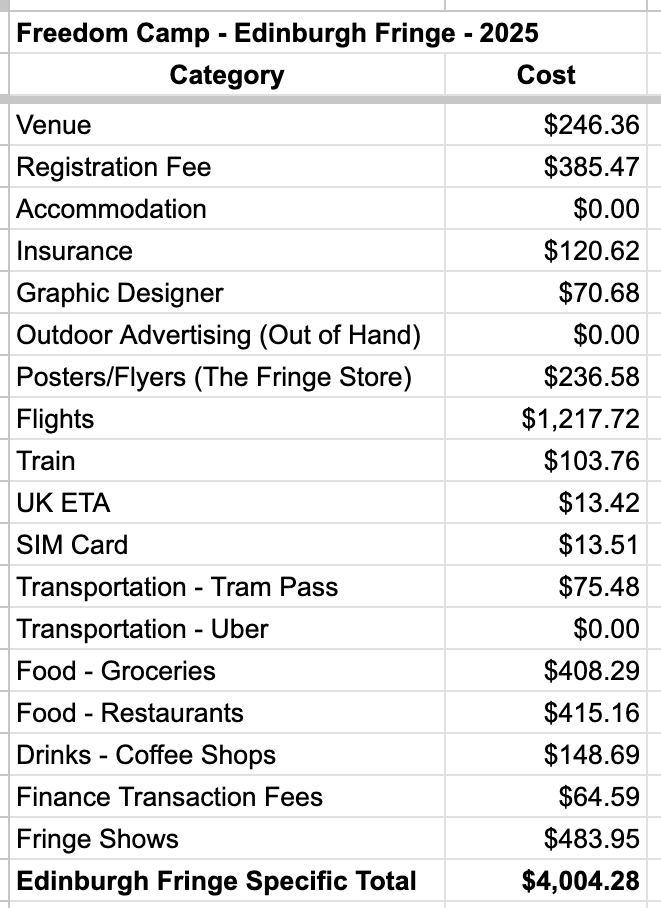My Real Fringe Budgets, Line-by-Line
When I decided to bring a show to the Edinburgh Fringe, I wanted to know one thing: how much does it cost? And I wanted a real number.
Not a guesstimate.
Not “It’s expensive!”
Not “It depends.”
A straightforward breakdown of what a person actually spends to take a solo show there.
Of course, nobody tells you this. Artists are either embarrassed, traumatized, or in denial. And I was no different—I procrastinated for months putting my final budget together because I knew how much I’d spent, but I didn’t want to open my bank statements and look directly at the sun.
Eventually, I sat down and totaled everything. My instincts were correct. The totals were painful. And I wish someone had shown me their numbers before I ever got on a plane to Scotland.
So, in the interest of transparency, here are mine.
I’ve brought two solo shows to the Fringe so far:
2024: The Balls of Philadelphia
2025: Freedom Camp
For each year, I divided costs into two categories:
1. Edinburgh Fringe Costs: Money spent specifically on taking the show to Edinburgh.
2. Show Development Costs: Money I would have spent creating the show even if it never went to Edinburgh.
Here are the totals:
2024: ~$8,400 Fringe costs + ~$3,300 development
2025: ~$4,000 Fringe costs + ~$4,700 development
I’ll break everything down, with screenshots, but first, here’s how I organized it.
How I Organized These Costs
1. Edinburgh Fringe Costs: The logistical, operational, unavoidable expenses required to actually perform in Edinburgh:
venue fees
registration fees
accommodation
flights and trains
food
marketing & advertising
seeing other shows
public transportation
anything else you pay for because you’re performing at Fringe
2. Show Development Costs: This is everything that went into making the show itself, including:
script workshops
private coaching / directing / dramaturgy
any props or materials that directly supported the show
These costs can be sneaky because they don’t always feel Fringe or show-related in the moment, but they absolutely contribute to what ends up on stage.
Some items blur categories (they always do). And yes, I’m sure I forgot something.
Also, some of these expenses won’t apply to everyone. For instance:
You may not pay an “expert” to help workshop your script.
Most shows require tech. Mine didn’t.
I don’t drink. If you do, budget for that.
2024 — The Balls of Philadelphia
Totals
Fringe costs: ~$8,400
Development costs: ~$3,300
Total: ~$11,700
Fringe-Specific Costs (2024)
Note: I was in a small room; a bigger one would have added a lot. I also didn’t hire PR—that would’ve been another $3,000+.
Show Development Costs (2024)
Workshops, feedback sessions, and everything that built the show.
Reflections on 2024
2024 was my first year at the Fringe and my first full-length solo show, so I was learning the ropes as I went.
I paid for a venue because I wanted to secure a space early.
I paid for outdoor ads because absolutely no one in Edinburgh knew who I was. They did help, but you still have to grind to get an audience in.
I lucked out with accommodation—a spare room in a family’s home in Leith, ensuite bath, 15 minutes from the center by tram.
The venue fee was the biggest shock: over $3,000 for 21 shows in a 22-seat room with noise bleed, and that’s before a single audience member walks in.
For full transparency: I was at Greenside • Riddles Court • Pickle Studio • 5pm.
Paid venues used to share the financial risk with artists, but that no longer seems to be the case. I paid their operational costs; I kept 100% of ticket revenue minus credit card fees, but even selling out wouldn’t have covered my expenses.
I also recommend budgeting to see other shows. Yes, it adds up, but it’s professionally necessary. It’s how you network, get better, and understand the ecosystem you’re walking into. Give free tickets to other artists; they nearly always return the favor.
By the end of August 2024, people kept asking, “Are you coming back next year?”
My answer: “If I don’t have to pay for it, sure.”
And then 2025 happened.
2025 — Freedom Camp
First: the family I’d stayed with in 2024 asked me to house-sit. That eliminated accommodation as an expense entirely.
Then in June, I snagged a Laughing Horse slot, which is a free venue. That alone removed $4,400 from my 2024 total. So I brought a new show even though it was still a work-in-progress.
Totals
Fringe costs: ~$4,000
Development costs: ~$4,700
Total: ~$8,700
Fringe-Specific Costs (2025)
Laughing Horse charges a small operational fee (for things like website hosting and mics). The rest was flights, food, transit, etc. House-sitting took care of the rest.
Because the show wasn’t finished, I didn’t invest in PR, marketing, or advertising.
Show Development Costs (2025)
My second show cost more to develop than my first. Why? I worked with someone highly credentialed, and expensive. In retrospect, I don’t think it was the right move for me.
Reflections on 2025
2025 was cheaper across the board except for development:
Free venue + house-sitting = instant savings.
Flights were pricier (Thailand → Scotland → U.S.), but manageable.
Staying longer blurred some “living” expenses with Fringe expenses.
Overall, much more affordable—except for the part where I paid nearly $5,000 to re-learn the lesson: trust yourself.
So What’s the Real Difference Between 2024 and 2025?
1. Venue fees
2024: ~$3,400
2025: ~$250
This alone explains most of the gap.
2. Accommodation
2024: ~$1,200
2025: $0
House-sitting is a gift.
3. Advertising
2024: ~$750
2025: $0
Outdoor ads moved the needle slightly, but not enough to justify a repeat. In 2025, most people found me through the Fringe app.
4. Development
2024: ~$3,300
2025: ~$4,700
Oops.
5. Length of stay
Extended house-sitting meant higher general living costs that weren’t completely Fringe-specific.
Advice for Anyone Thinking About Bringing a Solo Show to the Fringe
Financial
A free venue is the biggest money-saver. (I cannot say enough good things about Laughing Horse.)
House-sitting, flat-sharing, or sleeping on a floor will save you thousands.
Outdoor advertising: only if you have money to burn.
Budget realistically for food. Edinburgh is expensive in August.
Assume you’ll see $400–$600 worth of shows (~50 shows). It’s part of the job.
Creative
Coaching can help, but expensive does not mean effective for you.
You usually know what your show needs. Trust that even when it’s scary.
You cannot outsource the part of the show that is uniquely you.
Emotional
Yes, it’s expensive.
Yes, you’ll probably do it anyway.
Yes, it’s worth it.
But, still, trust your gut.
Final Thoughts
I don’t regret doing either show. I do wish someone had shown me their numbers beforehand, just to prepare me for the sticker shock.
So this post is my attempt to be the resource I needed two years ago.
If you’re thinking of bringing a show to the Fringe and you have questions—financial, creative, emotional, logistical—feel free to ask in the comments. I’m happy to talk about any of it.
And if you’ve done Fringe yourself, I’d love to hear what your numbers looked like. From what I’m told, what I’ve presented here is on the lower end of the spectrum!








